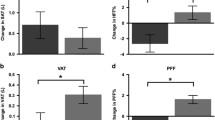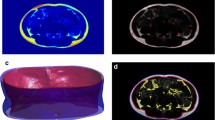Abstract
The current study was designed to examine the relationship between body fat distribution, as evaluated by anthropometry and magnetic resonance imaging (MRI), and circulating insulin, sex hormone and SHBG levels in obese adolescent girls. Twenty-nine obese adolescent girls, aged 12.6–16.9 years with a mean BMI of 30.51±1.86 participated in this study. All girls had breast stage B4-5 and pubic hair stage P4-5. Percent obesity and BMI as indices of being overweight were calculated; the waist-to-hip ratio (WHR) and the waist-to-thigh ratio (WTR) were calculated to obtain two anthropometric indices for the pattern of body fat distribution. The areas of visceral (VAT) and subcutaneous adipose tissue (SAT) were evaluated by MRI at the L4–L5 level. Serum concentrations of total T, DHEAS, 17β-estradiol, progesterone and SHBG were measured. Plasma glucose and insulin concentrations were evaluated during an oral glucose tolerance test. WHR was the only anthropometric parameter that was significantly associated with the area of VAT. Insulin level showed correlation with both WHR and the area of VAT; no correlation was found between insulin levels and WTR. Both WHR and VAT were negatively correlated with serum DHEAS level and positively correlated with T level. There were strong negative correlations between serum SHBG level and the area of VAT and WHR. Inverse correlation was found between serum SHBG level and insulin. Serum 17β-estradiol and progesterone levels showed no significant correlation with all the patterns of body fat distribution. SAT was not significantly correlated with both anthropometric parameters and any of the sex hormones evaluated. We can draw two main conclusions. Firstly, in massively obese adolescent girls, the WHR seems to be a good indicator for the accumulation of VAT, and abdominal obesity, rather than adiposity per se, appears to be related to biochemical complications. Secondly, increased upper body adiposity and, in particular, the intra-abdominal fat area are associated with increased insulin levels in massively obese adolescent girls. The associated reductions in SHBG and DHEAS levels represent an early general risk factor for the development of metabolic and cardiovascular diseases in this population, as previously described for obese adult women.
Similar content being viewed by others
References
Evans D.I., Hoffman R.G., Kalkhoff R.K., Kissebah A.H. Relationship of body fat topography and metabolic profiles in premenopausal women. Metabolism 1984, 33: 68–75.
Ohlson L.O., Larsson B., Svardsudd K., Welin L., Eriksson H., Wilhelmson L., Bjorntorp P., Tibblin G. The influence of body fat distribution on the incidence of diabetes mellitus. Diabetes 1985, 34: 1055–1058.
Haffner S.M., Stern M.P., Hazuda H.P., Pugh J., Patterson J.K. Do upper body and centralized adiposity measure different aspects of regional body fat distribution? Diabetes 1987, 36: 43–51.
Fujioka S., Matsuzawa Y., Tokunaga K., Tarni S. Contribution of intraabdominal fat accumulation to the impairment of glucose and lipid metabolism in human obesity. Metabolism 1987, 36: 54–59.
Bjorntorp P. The association between obesity, adipose tissue distribution and disease. Acta Med. Scand. 1988, 723 (Suppl.): 121–134.
Terry R.B., Wood P.D., Haskell W.L., Stafanick M.L., Krauss R.M. Regional adiposity patterns in relations to lipids, lipoprotein cholesterol and lipoprotein subfraction mass in men. J. Clin. Endocrinol. Metab. 1989, 68: 191–199.
Kanai H., Matsuzawa Y., Kotani K., Keno Y., Kobatake T., Nagai Y., Fujioka S., Tokunaga K., Tarni S. Close correlation of intra abdominal fat accumulation to hypertension in obese women. Hypertension 1990, 16: 484–490.
Fujimoto W.Y., Newell-Morris L.L., Grote M., Bergstrom R.W., Shuman W.P. Visceral fat obesity and morbidity: NIDDM and atherogenic risk in Japanese-American men and women. Int. J. Obes. Relat. Metab. Disord. 1991, 15: 41–44.
Evans D.J., Hoffmann R.G., Kalkhoff R.K., Kissebah A.H. Relationship of androgenic activity to body topography, fat cell morphology and metabolic aberrations in premenopausal women. J. Endocrinol. Metab. 1983, 57: 304–310.
Kissebah A.H., Freedman D.S., Peiris A. Health risks of obesity. Med. Clin. North Am. 1989, 73: 111–138.
De Pergola G., Giagulli V.A., Garruti G., Cospite M.R., Giorgino F., Cignarelli M., Giorgino R. Low dehydroepiandrosterone circulating levels in premenopausal obese women with very high body mass index. Metabolism 1991, 40: 187–190.
Giagulli V.A., De Pergola G., Giorgino F., Cignarelli M., Abbaticchio G., Vermeulen A., Giorgino R. Increased free testosterone but normal 5-alpha reduced testosterone metabolites in obese premenopausal women. Clin. Endocrinol. (Oxf.) 1992, 36: 553–558.
Weaver T.W., Kushi L.H., McGovern P.G., Potter J.D., Rich S.S., King R.A., Whitbeck J., Greenstein J., Sellers T.A. Validation study of self-reported measures of fat distribution. Int. J. Obes. Relat. Metab. Disord. 1996, 20: 644–650.
Weststrate J.A., Deuremberg P., van Tinteren H. Indices of body fat distribution and adiposity in Dutch children from birth to 18 years of age. Int. J. Obes. Relat. Metab. Disord. 1989, 13: 465–477.
Deuremberg P., Pieters J.J.L., Hautvast J.G.A. The assessment of intraabdominal and subcutaneous abdominal fat: relation between antropometry and computed tomography. Am. J. Clin. Nutr. 1990, 45: 7–13.
de Ridder C.M., de Boer R.W., Seidell J.C., Nieuwenhoff C.M., Jeneson J.A.L., Bakker C.J.G., Zonderland M.L., Erich W.B.M. Body fat distribution in pubertal girls quantified by magnetic resonance imaging. Int. J. Obes. Relat. Metab. Disord. 1992, 26: 443–449.
Fox K., Peters D., Armostrong N., Sharpe P., Bell M. Abdominal fat deposition in 11-year-old children. Int. J. Obes. Relat. Metab. Disord. 1993, 17: 11–16.
Brambilla P., Manzoni P., Sironi S., Simone P., Del Maschio A., Di Natale B., Chiumello G. Peripheral and abdominal adiposity in childhood obesity. Int. J. Obes. Relat. Metab. Disord. 1994, 18: 795–800.
Rolland Cachera M.F., Cole T.J., Sempe M., Tichet J., Rossignol C., Charraud A. Body mass index variations: centiles from birth to 18 years. Eur. J. Clin. Nutr. 1990, 45: 13–21.
Marshall W.A., Tanner J.M. Variations in pattern of pubertal changes in girls. Arch. Dis. Child. 1969, 44: 291–303.
Goran M.I., Kaskoun M., Shuman W.P. Intra abdominal adipose tissue in young children. Int. J. Obes. Relat. Metab. Disord. 1995, 19: 279–283.
Pedersen S.B., Borglum J.D., Schmitz O., Bak J.F., Sorensen N.S., Richelsen B. Abdominal obesity is associated with insulin resistance and reduced glycogen synthase activity in skeletal muscle. Metabolism 1993, 42: 998–1005.
Soler J.T., Folsom A.R., Kaye S., Prineas R.J. Associations of abdominal adiposity, fasting insulin, sex hormone binding globulin. Atherosclerosis 1989, 79: 21–27.
Haffner S.M., Katz M.S., Dunn J.F. Increased upper body and overall adiposity is associated with decreased sex hormone binding globulin in postmenopausal women. Int. J. Obes. Relat. Metab. Disord. 1991, 15: 471–478.
Peiris A.N., Mueller R.A., Smith G.A., Struve M.F., Kissebah A.H. Splanchnic insulin metabolism in obesity: influence of body fat distribution. J. Clin. Invest. 1986, 78: 1648–1657.
Peiris A.N., Mueller R.A., Struve M.F., Smith G.A., Kissebah A.H. Relationship of androgenic activity to splanchnic insulin metabolism and peripheral glucose metabolism in premenopausal women. J. Clin. Endocrinol. Metab. 1987, 64: 162–169.
Lindstedt G., Lundberg P.A., Lapidus L., Lundgren H., Bengtsson C., Bjorntorp A. Low sex hormone-binding globulin concentration as independent risk factor for development of NIDDM. Diabetes 1991, 40: 123–128.
Birkeland K.I., Hanssen K.F., Torjesen P.A., Vaaler S. Level of sex hormone binding globulin is positively correlated with insulin sensitivity in men with Type 2 Diabetes. J. Clin. Endocrinol. Metab. 1993, 7: 275–278.
Armellini F., Zamboni M., Castelli S., Robbi R., Mino A., Todesco T., Bergamo-Andreis I.A., Bosello O. Interrelationships between intradominal fat and total serum testosterone levels in obese women. Metabolism 1994, 43: 390–395.
De Pergola G., Zamboni M., Sciaraffia M., Turcato E., Pannacciulli N., Armellini F., Giorgino F., Perrini S., Bosello O., Giorgino R. Body fat accumulation is possibly responsible for lower dehydroepiandrosterone circulating levels in premenopausal obese women. Int. J. Obes. Relat. Metab. Disord. 1996, 20: 1105–1110.
Leenen R., van der Kooy K., Seidell J.C., Deurenberg P., Koppeschaar H.P. Visceral fat accumulation in relation to sex hormones in obese men and women undergoing weight loss therapy. J. Clin. Endocrinol. Metab. 1994, 78: 1515–1520.
Pedersen S.B., Borglum J.D., Brixen K., Richelsen B. Relationship between sex hormones, body composition and metabolic risk in premenopausal women. Eur. J. Endocrinol. 1995, 133: 200–206.
Nestler J.E., Barlascini C.O., Clore J.N. Dehydroepiandrosterone reduces serum low density lipoprotein levels and body fat but does not alter insulin sensitivity in normal men. J. Clin. Endocrinol. Metab. 1988, 66: 57–61.
Wild R.A., Alaupovic P., Givens G.R., Parker I.J. Lipoprotein abnormalities in hirsute women. Compensatory responses of insulin resistance and dehydroepiandrosterone sulphate with obesity. Am. J. Obstet. Gynecol. 1992, 167: 1813–1818.
Slowinska-Srzedincka J., Zglicznsti S., Ciswicka- Sznajderman M., Soszynski P., Biernacka M., Woroszylska M., Ruzyllo W., Sadowski Z. Decreased plasma dehydroepiandrosterone sulfate and dihydrotestosterone concentrations in young men after myocardial infarction. Atherosclerosis 1989, 79: 197–203.
De Pergola G., Triggiani V., Giorgino F., Cospite M.R., Garruti G., Cignarelli M., Guastamacchia E., Giorgino R. The free testosterone to dehydroepiandrosterone sulphate molar ratio as a marker of visceral fat accumulation in premenopausal obese women. Int. J. Obes. Relat. Metab. Disord. 1994, 18: 659–664.
Author information
Authors and Affiliations
Corresponding author
Rights and permissions
About this article
Cite this article
De Simone, M., Verrotti, A., Iughetti, L. et al. Increased visceral adipose tissue is associated with increased circulating insulin and decreased sex hormone binding globulin levels in massively obese adolescent girls. J Endocrinol Invest 24, 438–444 (2001). https://doi.org/10.1007/BF03351044
Accepted:
Published:
Issue Date:
DOI: https://doi.org/10.1007/BF03351044




